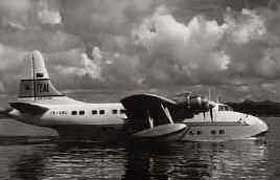‘Surviving’ here
would be easy
By Cleo Paskal, of the Toronto Star, Canada

Today … Air New Zealand Airbus A320-232
jets fly to Rarotonga International Airport.
Photo: Craig Murray, airliners.net

Before … TEAL Short Solent flying boat on the lagoon
at Aitutaki. Photo: Air New Zealand
This season’s Survivor series takes place on Aitutaki atoll in the Cook Islands. But they aren’t the first tender-footed wannabe stars from the big city to be abandoned here to fend for themselves.
For almost a decade, from 1951 to 1960, Aitutaki was one of the most legendary transit lounges on the planet. It was an age when air travel was still exotic, an event you dressed up for, and it didn’t get more glamorous than taking the Flying Boat along the Coral Route.
The lumbering, double-decker Solent aircraft that flew the route were more boat than plane. Pilots had to know not only how to read wind patterns but sea charts and currents.
Think of it as a mini-flying yacht. It had interiors with plush upholstery, a lounge, bar, a chef that cooked to order and even a place to nap. The 45 passengers were all in the same class: First.
STARTED
The route started in the morning in Auckland, New Zealand, where locals would come down to pier to see it take off — wondering each time how the steel elephant could not only float, but fly.
Mid-afternoon it would arrive in Suva, Fiji, where a fleet of limos would take passengers for afternoon tea and pink gins. They would be joined by passengers arriving on a connecting flight from the States.
This is where people like Marlon Brando, Cary Grant, John Wayne, Gary Cooper and Marlene Dietrich joined the flight. The Queen took the Solent from New Zealand in 1954.
After a night at Suva’s Grand Pacific, an elegant leftover colonial hotel, it was off to Samoa and another overnight at another colonial stand-by, Aggie Grey’s Hotel.
REFUEL
Then it was the long hop to Tahiti. Too long, in fact. The Flying Boat had to refuel en route. Which is where Aitutaki came in. It has a large sheltered lagoon, perfect for a quick refuelling stop.
Passengers were told to pack a bathing suit in their hand luggage and, while the plane got tanked up, the passengers did the same in a palm-fringed hut on shore — or lounged on the talcum beaches and washed the flight away in the warm, clear waters.
After a couple of hours, it was off again for Tahiti by nightfall (to be greeted by fire dancers).
But, sometimes, all didn’t go as planned. In 1955, the passengers, hair still wet from their dip in the Aitutaki lagoon, boarded the plane for take off to Tahiti. But one of the four engines failed to fire up.
STAR
The passengers (including French film star Martine Carol), their hand-tooled leather suitcases, a few cabin stewards and the plane’s food stores were dumped on a deserted beach and the limping plane juddered off to get fixed. It didn’t come back for eight days or, in Survivor-speak, almost three tribal councils.
In spite of abandoning a cargo of high-maintenance divas hundreds of kilometres from the closest hotel (or even powder room), when the plane finally did come back, they didn’t find a scene of social carnage. The locals had helped the passengers build shelters and, when their pâté and port ran out, taught them how to catch fish from the lagoon.
For many passengers it was one their best vacations ever and they didn’t want to leave.
Which just goes to show, when you don’t have Jeff Probst tormenting you, anything is possible.
FLIGHT
Today, Aitutaki atoll, consisting of three islands and about a dozen islets, is a bit more developed (there has to be at least one good hotel, or else where would Probst and crew stay?) There are regular flights from Rarotonga, the capital of the Cook Islands, but now the planes land on a proper runway.
Coming in for a landing, the lagoon of Aitutaki is a calm, opalescent green-blue jewel set in a choppy, steel-grey ocean.
Even locals stop chatting and look out their windows at its casual perfection. The plane is met with the same warmth, leis and coconuts that greeted Coral Routers.
And while the main island is a proper community with a school, hospital and churches, Akaiami, the islet where the Flying Boat used to refuel (and where some of the Survivor challenges were held) still has no permanent residents.
LODGE
To get there you need to take a boat and, once there, you can rent out the local timber and brass Lodge, modelled on the old TEAL (Tasman Empire Airways Limited, which became Air New Zealand) “transit lounge.”
I spent the afternoon there and, by the end, I was praying that the plane on my return flight would break down. Some things don’t change.

Headlines : Times 170
- Business as usual
- Its not over yet!
- Mama Ngai: It’s the village first
-Marurai people’s choice, says Dr Maoate,but....
- TANGI: MY WAY
- The trouble with Tangaroa
- ‘Surviving’ here would be easy
- WE’RE IN : Pacific Women in Media plan gets Cooks input
Headlines : Times 169
- JOB CHANGE HITS DEMOS
- Where election will be decided
- VIEWS: "Integrity: Is it important?"
- Letter to the Editor: Our genealogy through Rangi Makeakea
- Taio sails in to help
- William Kauvai stands up to a big man in his vaka
- Rhino Beetle battle ‘won’
- Cooks teen ‘froze’ as baby drowned